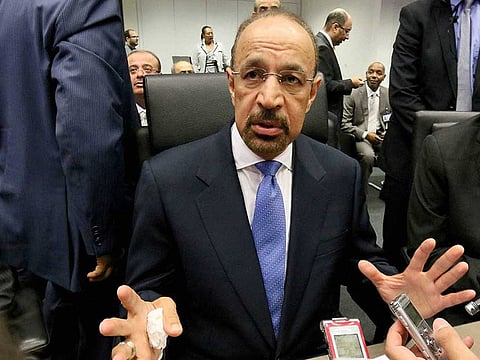Oil ministers upbeat about oil recovery
Saudi energy minister says the strategy of keeping output unchanged is working

Abu Dhabi: Oil ministers who gathered in Vienna for the Organisation of the Petroleum Exporting Countries (Opec) meet on Thursday were upbeat about oil price recovery and said the strategy of keeping the output unchanged is working.
“The strategy of keeping output unchanged is working with oil prices recovering and markets balancing. Opec countries notably Saudi Arabia did not have to drastically cut production,” said Khalid Al Falih, the new Energy Minister of Saudi Arabia.
He said the kingdom will not shock the oil market and will take a “gentle” approach as it wants long-term stability.
“Everybody is very satisfied with the market. The market is rebalancing as we speak. Demand is extremely healthy and robust. Non-Opec supply is declining. Prices will respond to the rebalancing of the market,” he told reporters in Vienna before the meeting.
“[In the past] prices have shot up too high, they have shot down too low and have stayed too low for too long, in my view.
“We think we are on the way up and we hope we will equalise somewhere moderate that encourages investment but not too much investment that encourages an oversupply and a glut again,” he said.
“The market is doing quite well by itself. We will be very gentle in our approach and make sure we don’t shock the market.”
He also said he would listen to any proposal Iran brings to the table later in the day.
The meeting takes places amid recovery in oil prices from less than $30 per barrel in January to around $50 per barrel. Opec did not cut oil output in order to support oil prices during the group’s previous meetings.
In his opening speech, Dr. Mohammad Bin Saleh Al Sada, Qatar’s Minister of Energy and Industry and President of the Opec Conference, said global exploration and production spending fell by around 20 per cent last year, and a further 15 per cent drop is anticipated this year.
“This is a major concern for an industry that generally sees investments increasing year on year to sustain production. It is important to keep in mind the link between the marginal cost of production, the oil price and investments.”
He predicted more balanced market in the second half of this year, with demand for Opec crude averaging around 32.5 million barrels per day during this period.
Meanwhile, Iranian Oil Minister Bijan Zanganeh said on Thursday Opec cannot control anything if it doesn’t set individual country production quotas and insisted Tehran deserved a high quota based on historic output.
Zanganeh said a fair quota for Iran should be 14.5 per cent of Opec’s overall oil output.
The group is producing 32.5 million barrels per day (bpd), which would give Iran a quota of 4.7 million bpd — well above its current output levels.
Oil ministers were optimistic that oil prices will go up. The UAE Energy Minister Suhail Al Mazroui said oil price will pick up in the second half of the year. He also said more appreciation in oil price is needed in order to sustain investment in the sector.
Iraqi Deputy Oil Minister Fayadh Al Nema said he expected the oil price to be $55 to $65 per barrel in the second half of this year. Kuwaiti acting Oil Minister Anas Al Saleh said on Thursday oil at $50 to $60 a barrel is an appropriate price.
On the other hand, Venezuela’s oil minister Eulogio del Pino proposed an “oil supply range” for individual Opec countries adding that such a range could substitute for talks on an output ceiling.
Venezuela’s crude production stood at around 2.8 million barrels per day last month. The country is on the brink of collapse due to low oil prices. According to media reports, people are going hungry and inflation has spiked.
Ole Hansen, Head of Commodity Strategy at Saxo Bank, told Gulf News that Opec will try to show unity but at the same time refraining from initiatives that would drive the market higher thereby risking ruining the gradual and longer term sustainable recovery.
“The introduction of a production limit will not have a fundamental impact but could still be short term bullish considering the recent failures.”
“The market focus has shifted away from Opec towards declining production in the US, while major but temporary supply disruptions in Canada, Nigeria and Venezuela helped balance the market during May. These events helped drive the price higher than what was otherwise warranted at this stage of the recovery.”
He expected both WTI and Brent crude maintain the established trading range between $45 and $50 in the short term.
“Depending on what kind of demand we will see across the Northern Hemisphere and especially in the US this summer we should see oil continue its ascent as we approach year-end. This should leave both oils trading within a $50 to $55 range by year-end. In 2017 the price should continue its ascent, albeit at a slower pace than what we have seen this year. We currently expect Brent to trade no higher than $65 by the end of 2017.”
— With inputs from Reuters
Sign up for the Daily Briefing
Get the latest news and updates straight to your inbox



